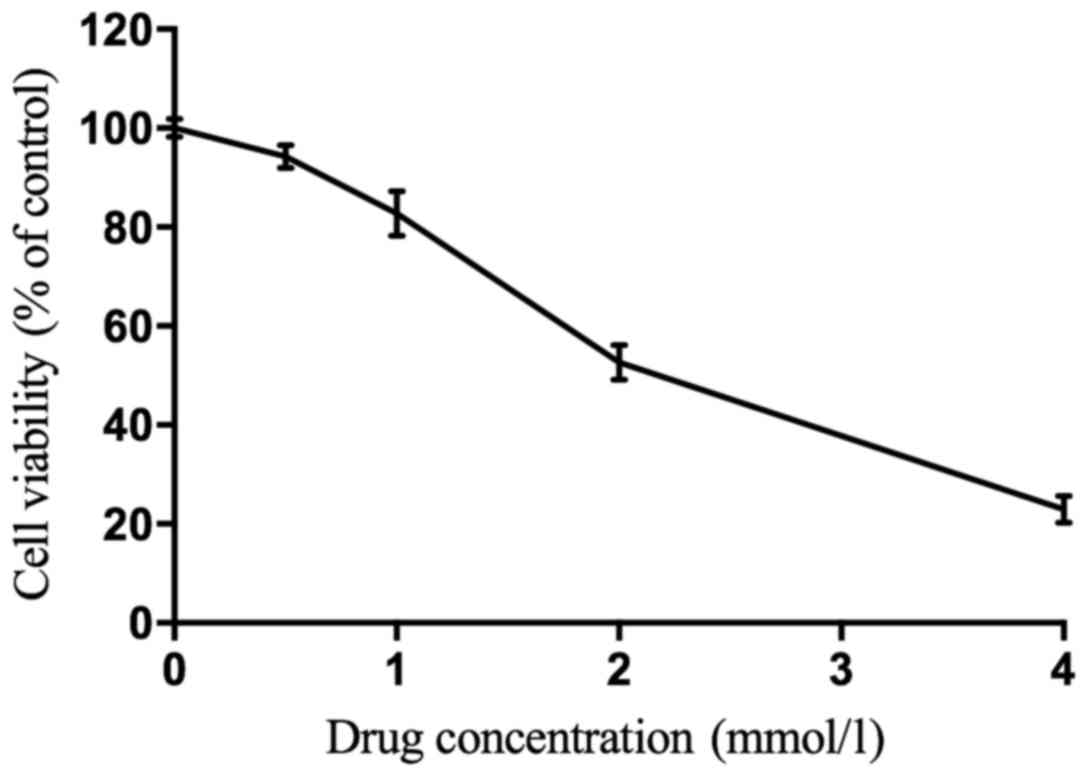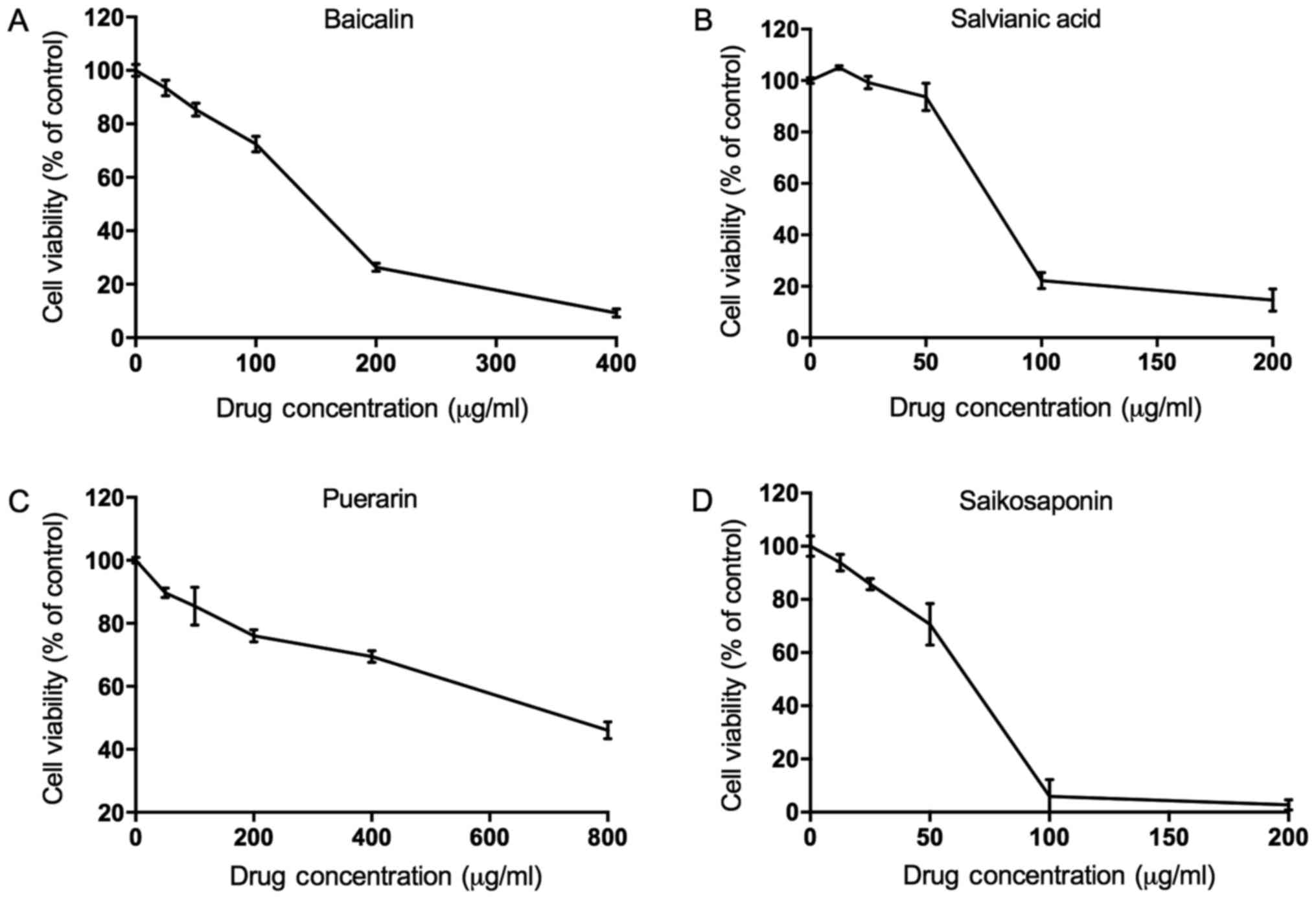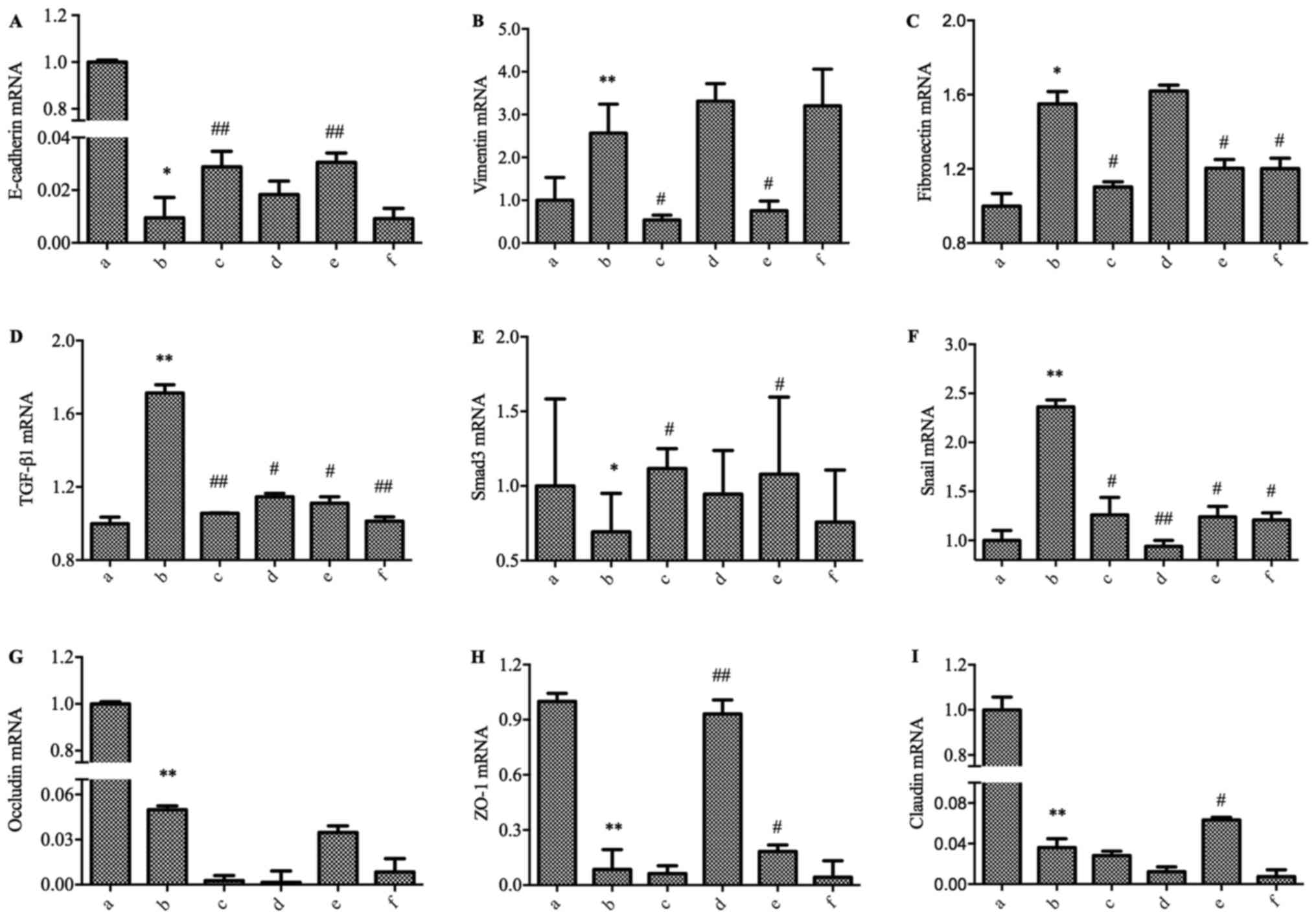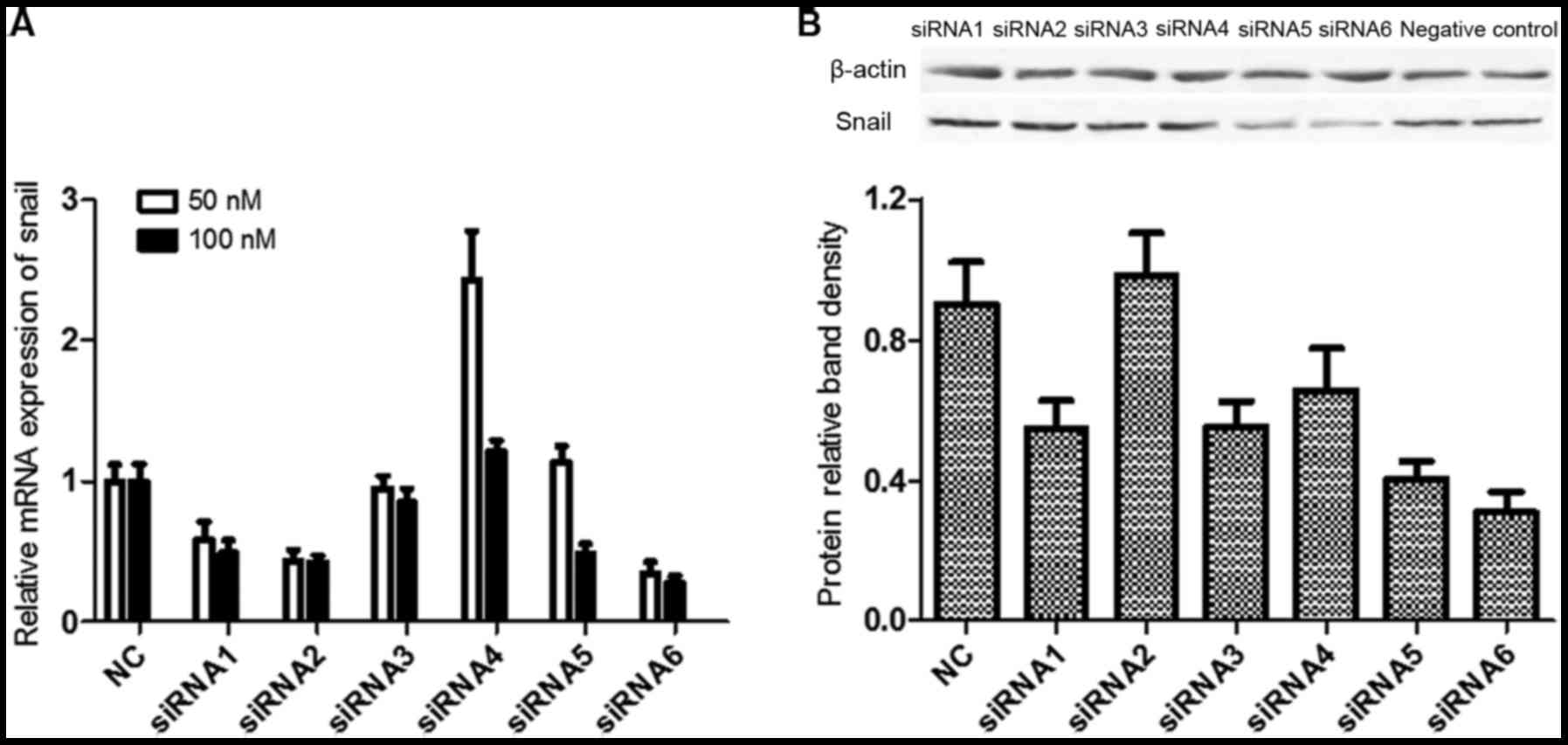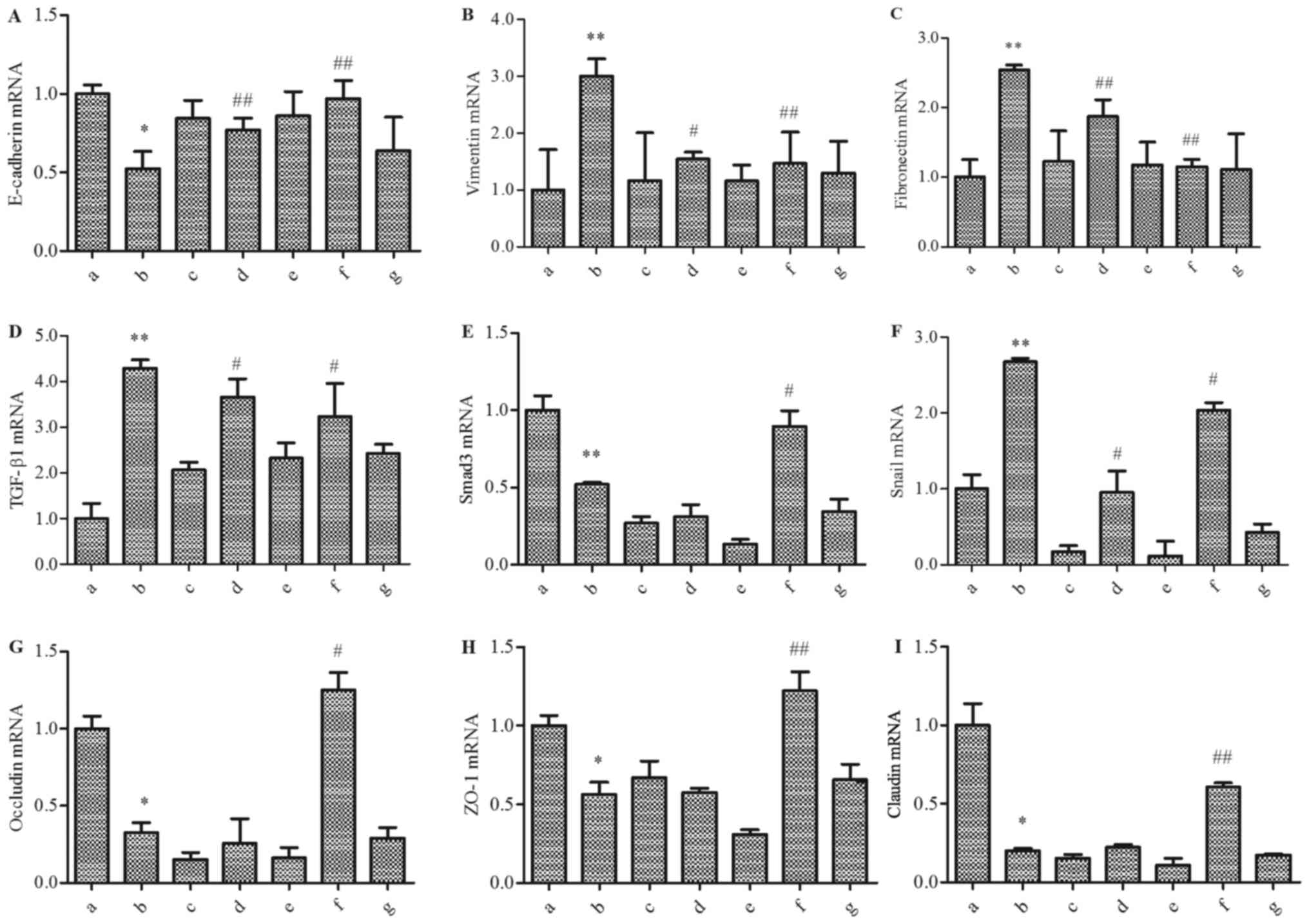|
1
|
Morgan TR: Treatment of alcoholic liver
disease. Gastroenterol Hepatol (N Y). 13:425–427. 2017.PubMed/NCBI
|
|
2
|
Centers for Disease C and Prevention
(CDC): Alcohol-attributable deaths and years of potential life
lost-United States, 2001. MMWR Morb Mortal Wkly Rep. 53:866–870.
2004.PubMed/NCBI
|
|
3
|
Hur K, Toiyama Y, Takahashi M, Balaguer F,
Nagasaka T, Koike J, Hemmi H, Koi M, Boland CR and Goel A:
MicroRNA-200c modulates epithelial-to-mesenchymal transition (EMT)
in human colorectal cancer metastasis. Gut. 62:1315–1326. 2013.
View Article : Google Scholar : PubMed/NCBI
|
|
4
|
Chen CL, Chen YH, Tai MC, Liang CM, Lu DW
and Chen JT: Resveratrol inhibits transforming growth
factor-β2-induced epithelial-to-mesenchymal transition in human
retinal pigment epithelial cells by suppressing the Smad pathway.
Drug Des Devel Ther. 11:163–173. 2017. View Article : Google Scholar : PubMed/NCBI
|
|
5
|
Zimowska M: Signaling pathways of
transforming growth factor beta family members. Postepy Biochem.
52:360–366. 2006.(In Polish). PubMed/NCBI
|
|
6
|
ten Dijke P and Hill CS: New insights into
TGF-beta-Smad signalling. Trends Biochem Sci. 29:265–273. 2004.
View Article : Google Scholar : PubMed/NCBI
|
|
7
|
Chen JM, Wang L and Xing LJ: Regulatory
effects of Qinggan Huoxue Recipe on matrix metalloproteinases of
alcoholic liver fibrosis rats. Zhongguo Zhong Xi Yi Jie He Za Zhi.
31:1538–1544. 2011.(In Chinese). PubMed/NCBI
|
|
8
|
Wu T, Liu T, Zheng PY, Xing LJ and Ji G:
Effects of Qinggan Huoxue Recipe and its separated recipes on the
expression of tumor necrosis factor-alpha in rats with alcoholic
liver injury. Zhong Xi Yi Jie He Xue Bao. 6:1145–1151. 2008.(In
Chinese). View Article : Google Scholar : PubMed/NCBI
|
|
9
|
Wu T, Liu T, Zhang L, Xing LJ, Zheng PY
and Ji G: Chinese medicinal formula, Qinggan Huoxue Recipe protects
rats from alcoholic liver disease via the
lipopolysaccharide-Kupffer cell signal conduction pathway. Exp Ther
Med. 8:363–370. 2014. View Article : Google Scholar : PubMed/NCBI
|
|
10
|
Wu T, Chen JM, Xiao TG, Shu XB, Xu HC,
Yang LL, Xing LJ, Zheng PY and Ji G: Qinggan Huoxue Recipe
suppresses epithelial-to-mesenchymal transition in alcoholic liver
fibrosis through TGF-β1/Smad signaling pathway. World J
Gastroenterol. 22:4695–4706. 2016. View Article : Google Scholar : PubMed/NCBI
|
|
11
|
Wang H, Zhang Y, Bai R, Wang M and Du S:
Baicalin attenuates alcoholic liver injury through modulation of
hepatic oxidative stress, inflammation and sonic hedgehog pathway
in rats. Cell Physiol Biochem. 39:1129–1140. 2016. View Article : Google Scholar : PubMed/NCBI
|
|
12
|
Wang CY, Ma FL, Liu JT, Tian JW and Fu FH:
Protective effect of salvianic acid a on acute liver injury induced
by carbon tetrachloride in rats. Biol Pharm Bull. 30:44–47. 2007.
View Article : Google Scholar : PubMed/NCBI
|
|
13
|
Zhao L, Wang Y, Liu J, Wang K, Guo X, Ji
B, Wu W and Zhou F: Correction to protective effects of genistein
and puerarin against chronic alcohol-induced liver injury in mice
via antioxidant, anti-inflammatory and anti-apoptotic mechanisms. J
Agric Food Chem. 64:84632016. View Article : Google Scholar : PubMed/NCBI
|
|
14
|
Zhao H, Li S and Zhang H, Wang G, Xu G and
Zhang H: Saikosaponin A protects against experimental sepsis via
inhibition of NOD2-mediated NF-κB activation. Exp Ther Med.
10:823–827. 2015. View Article : Google Scholar : PubMed/NCBI
|
|
15
|
Livak KJ and Schmittgen TD: Analysis of
relative gene expression data using real-time quantitative PCR and
the 2(-Delta Delta C(T)) method. Methods. 25:402–408. 2001.
View Article : Google Scholar : PubMed/NCBI
|
|
16
|
Larue L and Bellacosa A:
Epithelial-mesenchymal transition in development and cancer: Role
of phosphatidylinositol 3′kinase/AKT pathways. Oncogene.
24:7443–7454. 2005. View Article : Google Scholar : PubMed/NCBI
|
|
17
|
Blick T, Widodo E, Hugo H, Waltham M,
Lenburg ME, Neve RM and Thompson EW: Epithelial mesenchymal
transition traits in human breast cancer cell lines. Clin Exp
Metastasis. 25:629–642. 2008. View Article : Google Scholar : PubMed/NCBI
|
|
18
|
Liu J, Zeng L, Zhao Y, Zhu B, Ren W and Wu
C: Selenium suppresses lipopolysaccharide-induced fibrosis in
peritoneal mesothelial cells through inhibition of
epithelial-to-mesenchymal transition. Biol Trace Elem Res.
161:202–209. 2014. View Article : Google Scholar : PubMed/NCBI
|
|
19
|
Xie Y, Liao R, Pan L, Fan K, Peng C and Du
C: Hepatic stellate cell conditioned medium induces proliferation
and epithelial-mesenchymal transition via activating ERK1/2
signaling pathway in hepatoma cells. Xi Bao Yu Fen Zi Mian Yi Xue
Za Zhi. 33:210–214. 2017.(In Chinece). PubMed/NCBI
|
|
20
|
Park JH, Park B and Park KK: Suppression
of hepatic epithelial-to-mesenchymal transition by melittin via
blocking of TGFβ/Smad and MAPK-JNK signaling pathways. Toxins
(Basel). 9:2017. View Article : Google Scholar
|
|
21
|
Carl C, Flindt A, Hartmann J, Dahlke M,
Rades D, Dunst J, Lehnert H, Gieseler F and Ungefroren H: Ionizing
radiation induces a motile phenotype in human carcinoma cells in
vitro through hyperactivation of the TGF-beta signaling
pathway. Cellular and molecular life sciences: CMLS. 73:427–443.
2016. View Article : Google Scholar : PubMed/NCBI
|
|
22
|
Valcourt U, Kowanetz M, Niimi H, Heldin CH
and Moustakas A: TGF-beta and the Smad signaling pathway support
transcriptomic reprogramming during epithelial-mesenchymal cell
transition. Mol Biol Cell. 16:1987–2002. 2005. View Article : Google Scholar : PubMed/NCBI
|
|
23
|
Muthusamy BP, Budi EH, Katsuno Y, Lee MK,
Smith SM, Mirza AM, Akhurst RJ and Derynck R: ShcA protects against
epithelial-mesenchymal transition through compartmentalized
inhibition of tgf-β-induced smad activation. PLoS Biol.
13:e10023252015. View Article : Google Scholar : PubMed/NCBI
|
|
24
|
Kong D, Zhang F, Shao J, Wu L, Zhang X,
Chen L, Lu Y and Zheng S: Curcumin inhibits cobalt chloride-induced
epithelial-to-mesenchymal transition associated with interference
with TGF-β/Smad signaling in hepatocytes. Lab Invest. 95:1234–1245.
2015. View Article : Google Scholar : PubMed/NCBI
|
|
25
|
Wang QL, Tao YY, Yuan JL, Shen L and Liu
CH: Salvianolic acid B prevents epithelial-to-mesenchymal
transition through the TGF-beta1 signal transduction pathway in
vivo and in vitro. BMC Cell Biol. 11:312010. View Article : Google Scholar : PubMed/NCBI
|
|
26
|
Puisieux A, Brabletz T and Caramel J:
Oncogenic roles of EMT-inducing transcription factors. Nat Cell
Biol. 16:488–494. 2014. View
Article : Google Scholar : PubMed/NCBI
|
|
27
|
Sciacovelli M, Goncalves E, Johnson TI, Wu
L, Zhang X, Chen L, Lu Y and Zheng S: Fumarate is an epigenetic
modifier that elicits epithelial-to-mesenchymal transition. Nature.
537:544–547. 2016. View Article : Google Scholar : PubMed/NCBI
|
|
28
|
Xia W, Ma X, Li X, Dong H, Yi J, Zeng W
and Yang Z: miR-153 inhibits epithelial-to-mesenchymal transition
in hepatocellular carcinoma by targeting Snail. Oncol Rep.
34:655–662. 2015. View Article : Google Scholar : PubMed/NCBI
|
|
29
|
Lopez-Terrada D, Cheung SW, Finegold MJ
and Knowles BB: Hep G2 is a hepatoblastoma-derived cell line. Human
Pathol. 40:1512–1515. 2009. View Article : Google Scholar
|















